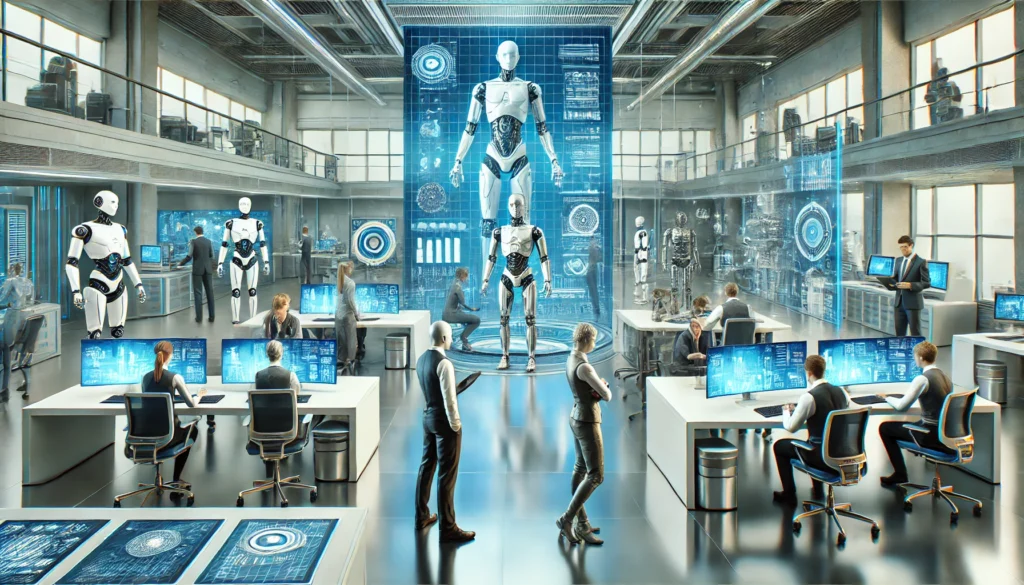Understanding Human-Machine Interfaces: Enhancing Interaction and Productivity

Introduction to Human-Machine Interfaces (HMIs)
Human-Machine Interfaces (HMIs) serve as the vital linchpin that connects human operators with machines and systems. At its core, an HMI is any interface that allows users to interact effectively with complex machinery or computerized systems. Historically, this concept has evolved significantly, beginning with rudimentary mechanical levers and gears, which allowed for direct physical manipulation, and advancing to today’s sophisticated digital touchscreens and voice-activated commands.
The evolution of HMIs has been pivotal across various epochs, mirroring advancements in technology. The industrial revolution marked the onset of early mechanical interfaces that enabled factory operators to control machinery with greater precision. With the advent of digital technology in the mid-20th century, control panels with buttons and lights became prevalent, reducing the complexity of machine operations. The turn of the 21st century introduced graphical user interfaces (GUIs), which leveraged visual icons and touchscreen capabilities, making interactions more intuitive and user-friendly.
HMIs have become indispensable across a multitude of fields. In manufacturing, HMIs enhance productivity and safety by allowing operators to monitor and control processes in real-time through accessible user dashboards. These interfaces help in identifying issues promptly and implementing solutions efficiently. In the realm of healthcare, HMIs are instrumental in medical devices, aiding professionals in diagnostics and patient care by providing seamless access to patient data and equipment controls. Consumer electronics, omnipresent in daily life, heavily rely on HMIs; from smartphones to home automation systems, they provide users with an intuitive experience that simplifies complex operations.
In essence, Human-Machine Interfaces bridge the gap between humans and machines, transforming mechanical complexity into manageable and enhanceable user experiences. Their importance cannot be overstated, as they continue to evolve and adapt to meet the demands of an increasingly digital and automated world. The ongoing advancements in HMIs signify not just a technological evolution, but also a fundamental shift in how humans interact with and derive value from machines.
Key Components and Technologies Behind HMIs
Human-Machine Interfaces (HMIs) are complex systems composed of multiple hardware and software components designed to enhance user interaction and productivity. Among the primary hardware components are sensors, touchscreens, and control panels. Sensors play a critical role in detecting and interpreting physical inputs, such as touch, pressure, and motion, which are then translated into actionable commands. Touchscreens have revolutionized HMIs by offering an intuitive and direct mode of interaction, allowing users to manipulate on-screen elements with ease. Control panels, often featuring a combination of buttons, switches, and dials, serve as traditional yet reliable means for user input and control.
On the software side, user interface (UI) design and usability testing are pivotal. An effective UI design prioritizes clarity, simplicity, and responsiveness to ensure users can interact with the system efficiently. Usability testing is conducted to evaluate the interface’s effectiveness and identify areas for improvement, ensuring the HMI is user-friendly and meets the needs of its intended audience.
Modern HMIs are increasingly leveraging advanced technologies such as artificial intelligence (AI), machine learning (ML), and the Internet of Things (IoT). AI and ML enable HMIs to adapt to user behaviors by learning preferences and patterns, thereby providing personalized and predictive interactions. For instance, AI-driven voice recognition systems can understand and respond to natural language commands, making them more accessible and convenient for users.
The integration of IoT further enhances HMIs by facilitating seamless communication between devices. IoT-connected HMIs can gather data from various sensors and devices, process this information in real-time, and provide actionable insights to users. This interconnected ecosystem allows for smarter, more responsive interfaces that can improve overall efficiency and productivity.
In summary, the fusion of hardware elements like sensors, touchscreens, and control panels with advanced software technologies such as AI, ML, and IoT is transforming HMIs into sophisticated, user-centric solutions. These advancements are paving the way for more intuitive and productive interactions between humans and machines, catering to the evolving demands of modern industries and applications.
Applications of HMIs Across Different Industries
Human-Machine Interfaces (HMIs) have become integral across a multitude of sectors, each leveraging the technology to enhance user experience, improve efficiency, and drive innovation. In the manufacturing industry, HMIs are pivotal for automation and quality control. They facilitate the seamless interaction between operators and machinery, enabling real-time monitoring and adjustment of production processes. These interfaces often provide detailed data analytics that help in predictive maintenance, reducing downtime and improving overall productivity.
In healthcare, HMIs are transforming patient care and surgical procedures. Advanced HMIs allow medical professionals to monitor patients’ vital signs continuously, ensuring timely interventions. In surgical environments, HMIs support robotic assistance, enabling surgeons to perform complex procedures with precision and minimal invasiveness. This integration not only improves patient outcomes but also enhances the efficiency of healthcare delivery systems.
The automotive industry has also seen significant advancements with the adoption of HMIs. Modern vehicles are equipped with sophisticated navigation systems that provide real-time traffic updates, alternative routes, and driver assistance features. Infotainment systems within vehicles offer an array of functionalities such as voice control, touch interfaces, and connectivity with smartphones, ensuring a safer and more enjoyable driving experience.
In the realm of consumer electronics, HMIs play a crucial role in the usability and functionality of devices. From smartphones to tablets to wearable technology, user interfaces are designed to be intuitive, facilitating ease of use. Smart home systems, another growing application of HMIs, integrate various home devices and appliances, allowing users to control lighting, heating, security, and entertainment systems through centralized interfaces or even voice commands.
The gaming industry has significantly leveraged HMIs to enhance player engagement and interaction. Advanced graphics, motion sensors, and virtual reality interfaces create immersive gaming experiences. These innovations not only improve the gaming experience but also push the boundaries of technology and creativity.
While the benefits of HMIs across these industries are evident, challenges remain. Issues such as user privacy, data security, and the need for user-friendly designs must be addressed. Nevertheless, the continuous evolution of HMI technology promises to further revolutionize how humans interact with machines, driving forward progress and efficiency in diverse domains.
Future Trends and Challenges in HMI Development
As technology continues to advance at a rapid pace, the future of Human-Machine Interfaces (HMIs) promises significant transformations. One of the groundbreaking trends is the development of more immersive interfaces, particularly through augmented reality (AR) and virtual reality (VR). These technologies are poised to revolutionize how users interact with machines, providing highly engaging and intuitive user experiences. By overlaying digital information on the physical world or creating entirely virtual environments, AR and VR can enhance productivity and offer new dimensions of interaction.
Additionally, there is an increasing reliance on voice and gesture controls in HMI systems. Voice recognition technologies, powered by advancements in natural language processing (NLP), enable more seamless and hands-free interactions. Similarly, gesture control allows users to execute commands through natural movements, improving efficiency and reducing the need for physical touch. These innovations are particularly valuable in settings where traditional input methods are less practical, such as in medical or industrial environments.
Despite these promising advancements, several challenges persist. Ensuring cybersecurity remains a paramount concern, as more sophisticated HMIs also mean more complex systems that can be vulnerable to cyber-attacks. Protecting user privacy is another critical issue, especially as interfaces become more personalized and collect more data. Users must be reassured that their information is secure and used responsibly.
Moreover, the rapidly evolving landscape of user expectations necessitates continuous innovation. HMIs must be adaptable and scalable to keep pace with technological progress and changing user needs. This requires ongoing investment in research and development, as well as collaboration across industries to share knowledge and best practices.
To overcome these challenges, adopting a layered approach to cybersecurity, promoting transparent data handling policies, and investing in continuous user feedback can be effective strategies. Leveraging advances in AI and machine learning can also help to anticipate and meet evolving user demands proactively.
In conclusion, the future of HMIs is both exciting and challenging. By focusing on innovation, security, and user-centric design, the potential for HMIs to significantly enhance interaction and productivity is immense.






Responses